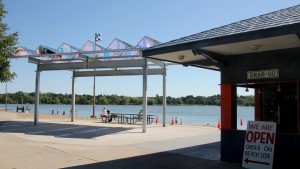Story and photo by TESHA M. CHRISTENSEN
The new solar power installation at Nokomis Beach is up and running, and will soon supply an estimated 10.9% of total annual energy consumed at the beach. Plus, it created more shade.
 An 18-panel array was mounted atop a large shade structure near Sandcastle restaurant (photo right). Sandcastle remained open during the construction, which began this spring and ended in August. The panels were connected to Xcel’s equipment and began generating electricity for Lake Nokomis Park on Aug. 17.
An 18-panel array was mounted atop a large shade structure near Sandcastle restaurant (photo right). Sandcastle remained open during the construction, which began this spring and ended in August. The panels were connected to Xcel’s equipment and began generating electricity for Lake Nokomis Park on Aug. 17.
First solar installation paid for by Xcel grant
The 7.4kW solar installation is estimated to provide 9,578-10,321 kWh per year.
The Titan 410W Mono PV Modules with reflectors were manufactured by TenKsolar in Bloomington. Installation was done by Sundial Solar and Merit Electric under the direction of Graybar Electric.
The construction cost (not including design and other related design and administration costs) was approximately $180,000.
“The project is the result of a great partnership,” said Benjamin Johnson of the Minneapolis Park and Recreation Board (MPRB). “It was primarily funded by Xcel Energy’s Renewable Development Fund, but the Minneapolis Park and Recreation Board has also provided $150,000 in funding as a match to the RDF grant.”
MPRB applied for an Xcel Energy Renewable Development Fund grant in 2013, and learned in 2014 that it was among 20 out of 67 applicants to receive funding.
The $969,741 grant helped fund five projects. The largest, at Parade Ice Garden, has 374 solar panels in 21 sections, which generates roughly 15% of the building’s annual electrical consumption. Each solar panel is paired with a reflector panel to maximize energy density.
“It’s great to partner with the Minneapolis Park Board on their energy efficiency work and their first-ever solar installation at Parade Ice Garden,” said Lee Gabler, Xcel Energy Senior Director of Customer Strategy and Solutions. “This solar array is another example of public and private partners, working together, to promote renewable energy use.”
“Renewable energy infrastructure helps to reduce the parks’ carbon footprint, and with the significant costs associated with implementation, I am thankful that we received such a generous grant from Xcel Energy to build out some sites within the system,” stated District 5 Parks Commissioner Steffanie Musich.
Nokomis site one of five
Solar panels have also been installed at Webber Natural Swimming Pool (on pump house roof); East Phillips Community and Cultural Center (roof); and Rev. Dr. Martin Luther King, Jr. Park (roof of the multipurpose room).
Project locations were selected based on solar orientation (to maximize sunlight exposure), public visibility and distribution across the Minneapolis park system, according to Johnson. Roof capacity and roof longevity were major factors in determining the location for the major installation at Parade Ice Garden.
The original plan to install solar panels at the Lake Calhoun Refectory (Tin Fish) was scraped because the building needed extensive structural modifications to support a solar system. The new Northeast Athletic Field Recreation Center is expected to receive a small roof-mounted solar system in 2018, but it will not be funded by Xcel RDF grant due to timing and funding constraints.
Annually, the combined projects produce roughly 280,000 kilowatt hours, offset 400,000 pounds of carbon, and reduce MPRB electricity bills by roughly $28,000.
The projects also include interpretive and educational programming opportunities about sustainable solar energy for both children and adults in Minneapolis parks.
A mounted educational sign will be installed onsite at Lake Nokomis this fall. The sign will provide information about solar energy and specifics about the Nokomis solar installation. Also, small signs containing a QR code that can be scanned to view a video about the projects will be installed on nearby picnic tables.
“Providing demonstration projects using solar energy makes solar production visible to the community. This supports a culture around promoting renewable energy and sustainability,” remarked Johnson.
Solar benefits
These solar projects not only benefit park users but city residents in general.
“Each solar installation reduces our carbon footprint. Our carbon footprint is the total amount of greenhouse-gas emissions from fossil fuel,” pointed out Johnson. “When we reduce our carbon footprint, it reduces the amount of natural resources we consume.”
Solar power reduces the need to expand the electrical grid, which saves everyone costs on utility bills, as well as natural resources needed for expanding the electrical grid for increased demand.
Solar energy is a ‘clean’ energy source in comparison to other types of energy generation. Photovoltaic solar power makes no noise, creates no emissions, has no moving parts, uses no water or other fuels and requires very little maintenance.
Using solar energy not only saves on electrical costs in the short term but may also be a good long-term investment. Energy prices are rising while the cost of a solar installation is dropping.
This project supports local solar production.
All of the solar installations used solar modules that were reviewed by the Department of Commerce and designated as Made In Minnesota.
Comments
No comments on this item Please log in to comment by clicking here